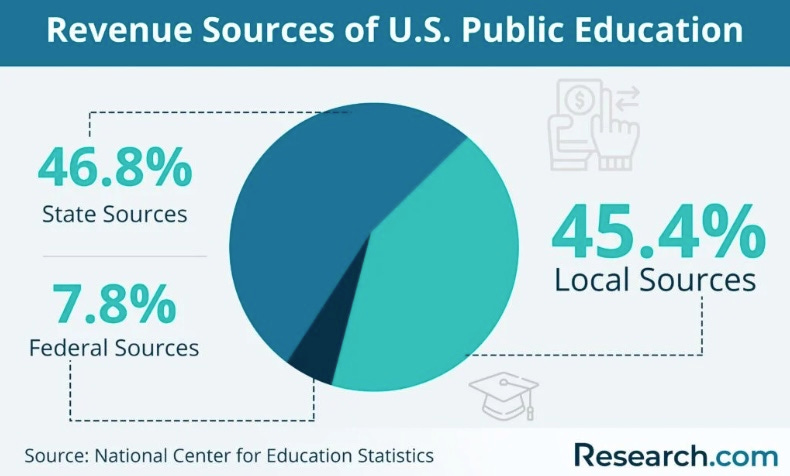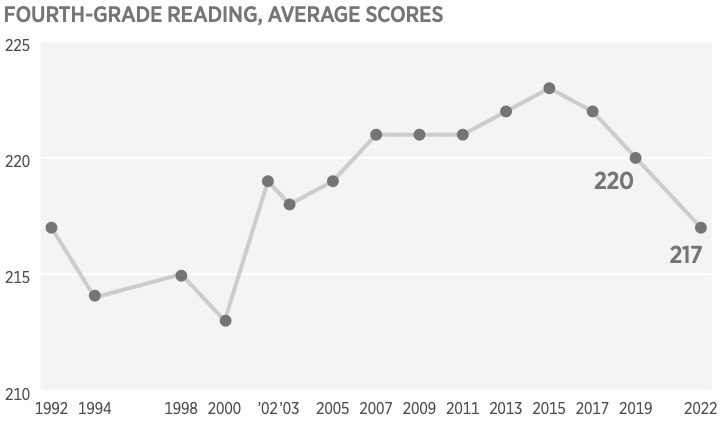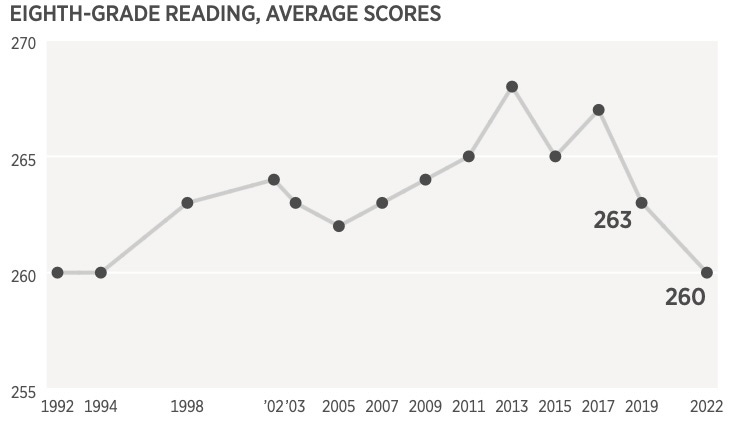Project 2025: Cut Federal Aid to Schools
If implemented, these prescriptions would decimate aid to public schools and students.
The right-wing assault on higher education followed the attack on elementary and secondary education that included teachers, teachers’ unions, and state departments of education. This prior incursion did not simply bubble up organically from concerned parents, although it did take advantage of some of their complaints about public schools. Rather, the attack was driven and coordinated by organizations such as the Heritage Foundation, the Manhattan Institute, and the Goldwater Institute. The American Legislative Exchange Council (ALEC) distributed model legislation to friendly state legislators. All this came to a head following the murder of George Floyd and subsequent protests in 2020.
Project 2025 comprises a comprehensive summary of policy recommendations for elementary, secondary, and higher education along with other areas of American government and policy. As Kevin Roberts, President of the Heritage Foundation, states in his Forward, “This book, this agenda, the entire Project 2025 is a plan to unite the conservative movement and the American people against elite rule and woke culture warriors.”[1]
In addition to calling for the elimination of the U.S. Department of Education (ED), the authors of Project 2025 recommend that funds now spent on federally managed education programs “should be block-granted to states without strings.” One goal is to eliminate “the need for many federal and state bureaucrats.” But another is to make sure that “policymaking and funding should take place at the state and local level” especially for secondary K-12 schools.[2]
The proposal to distribute block grants “without strings” and to fire “bureaucrats” provides a clue about the authors’ underlying objectives. In plain language, the authors express the following concerns about secondary education:
Expenditure of federal tax dollars has not resulted in academic improvement among secondary school students.
States should be permitted to direct publicly raised funds toward public or private schools according to parental choice.
Parental control means that elementary and secondary schools should not teach “gender ideology and critical race theory.”[3]
Let’s consider each of these concerns.
Student Achievement
Throughout the chapter, the authors argue that American taxpayers are not getting a sufficient return on their investment. The simple fact that only 8% of money spent on education is distributed by ED while the remaining 92% comes from the states[4] goes unmentioned.
In truth, state and local funding far outstrips federal contributions.
Moreover, Project 2025 contends that, despite massive outlay of federal dollars, ED programs have not resulted in improved academic performance for American elementary and secondary school students. As evidence, the authors include the following charts[5]:
Astoundingly, these charts undermine Project 2025’s argument. Notice that improvement in reading scores occurred through the years of the Obama administration. Sharp declines, however, occurred during the Trump administration years (including the COVID-19 pandemic).
More specifically, Project 2025 advocates eliminating the Office of Elementary and Secondary Education (OESE) and the Office of Special Education and Rehabilitative Services (OSERS).[6]
Funding under OESE (Title I) that supports lower-income schools would be transferred to the Administration for Children and Families in the Department of Health and Human Services (HHS). Similarly, all “Indian” education programs would be transferred to the Bureau of Indian Education. Other revenue and programs managed by OESE would be distributed to states, if necessary, as no-strings block grants.[7]
The glaring problem with this proposal is that many states routinely underfund low-income schools. Thus, there is every reason to foresee that state officials would divert block grants to other “lawful” purposes even outside education.
Programs such as Individuals with Disabilities Education Act (IDEA) would be phased out or directed to local education agencies by HHS. Programs under the Office of Special Education and Rehabilitative Services (OSERS) that prohibit discrimination against persons with disabilities would be transferred to the Department of Justice (DOJ) Office of Civil Rights (OCR).
It should go without saying that such actions would dilute the current focus by IDEA and OSERS on supporting students with disabilities and special needs and force such measures to compete for attention and resources in other agencies which must attend to a multitude of other priorities. Such a policy would also remove involvement of education specialists from administering such programs – with disastrous results.
Title IX Protections
Project 2025 is highly critical of ED’s recent regulatory extension of protections against discrimination under Title IX (of the Education Amendments 1972) to include LGBTQI+ individuals.
“[T]he Biden Administration has sought to trample women’s and girls’ athletic opportunities and due process on campus, threaten free speech and religious liberty, and erode parental rights in elementary and secondary education regarding sensitive issues of sex.”[8]
Accordingly, the authors urge Congress to amend Title IX to “define ‘sex’ under Title IX to mean only biological sex recognized at birth; and strengthen protections for faith-based educational institutions, programs, and activities.”[9] Doing so would explicitly roll back regulations to ED definitions under former ED Secretary Betsy DeVos.
Project 2025 directs toward all federal departments and agencies its objections to ED regulations that would withhold federal funding from state and local agencies or organizations that discriminate against persons because of “sexual orientation or gender identity.” Moreover, the authors insist that no public education institution or employee should be permitted to use a student’s name or pronoun that differs from a student’s biological sex without parental consent. Neither should any public employee be required to use a student’s pronoun if it differs from that student’s biological sex if doing so is contrary to that employee’s religious or moral convictions.[10]
Rescinding these broader Title IX protections, as widespread discussion shows, would inflict immense harm on students who grapple with gender identity issues.
School Choice and Parental Control
Throughout, the chapter on education calls for expanding parents’ ability to use public education dollars that would be spent by public schools to educate their children in support of charter or private schools. The example of Arizona and other states is frequently cited as the basis for a national plan. Further,
“Parents should be allowed to use their child’s Title I resources to help pay for private learning options including tutoring services and curricular materials.
“Over a 10-year period, the federal spending [for Title I] should be phased out and states should assume decision-making control over how to provide a quality education to children from low-income families.”[11]
More broadly, “any federal policies should be strictly designed so they do not conflict with state activities.”[12]
Obviously, such proposals would return education and other policies to pre-World War II days. Indeed, they are merely a modern version of pre-Civil War and Jim/Jane Crow states’ rights arguments. They threaten to roll back hard-won progress in recent decades of education and civil rights. And they provide a foundation for attacks on teachers, teachers’ unions, and other so-called education experts. This is truly the ideological heart of the entire chapter on education.
“To restore state and local control of education and reduce the bureaucratic and compliance burden, Congress should allow states to opt out of the dozens of federal K–12 education programs authorized under the Elementary and Secondary Education Act, and instead allow states to put their share of federal funding toward any lawful education purpose under state law.”[13]
Such a recommendation is the procedural context for the authors’ insistence that diversity, equity, and inclusion (DEI) and critical race theory (CRT) should never be taught.[14] They contend that such instruction would be harmful to students and would violate parental rights to have such instruction excluded.
Of course, the authors never define DEI or CRT. Never. Throughout, DEI is merely a code word for racial and sexual diversity, regardless of context or intent. Similarly, CRT simply stands for any consideration of racial animosity or discrimination, including historical discussions of slavery and its consequences.
Most importantly, the authors completely ignore the conclusion of many experts that neither DEI nor CRT are taught in elementary or secondary public schools.
Conclusion
For K-12 schools and their students, Project 2025’s chapter on education portends disastrous consequences.
Funding for educating low-income students and students with disabilities will be left to the whims of state legislatures and, thereby, likely to be cut.
Support for public education will be drastically eroded and efforts to improve public schools curtailed.
The civil rights of students who are neither white nor sexually heteronormative will come under extreme threat.
Education at the elementary and secondary level will become increasingly oriented toward indoctrinating students into an uncritical “American exceptionalism” that ignores the profoundly pluralistic, diverse society in which we must live.
Getting assistance for schools, teachers, and students after funding and programs are transferred to the states and other non-education agencies will resemble a street shell game – you know, where you are trying to guess which of three rapidly moving shells conceals the pea. In this case, there will likely be no pea at all.
Next in this series, as I turn to considering Project 2025’s detailed prescriptions for higher education, many of these issues will return in slightly different form. Stay tuned.
And please continue the discussion in the comments section which is open to all for this series.
NOTES:
[1] Kevin D. Roberts, “Forward” in Paul Dans and Steven Groves, eds., Mandate for Leadership: The Conservative Promise (Washington, DC: The Heritage Foundation, 2023), p. 16. Hereafter cited as “Project 2025.” https://static.project2025.org/2025_MandateForLeadership_FULL.pdf.
[2] Project 2025 p. 320.
[3] Project 2025, p. 322.
[4] Imed Bouchrika, “U.S. Public Education Spending Statistics for 2024,” Research.com, June 11, 2024, U.S. Public Education Spending Statistics for 2024 | Research.com.
[5] The Nation’s Report Card, “National Average Scores,” Grade 4, https://www.nationsreportcard.gov/ reading/nation/scores/?grade=4 (accessed March 17, 2023), and The Nation’s Report Card, “National Average Scores,” Grade 8, https://www.nationsreportcard.gov/reading/nation/scores/?grade=4 (accessed March 17, 2023).
[6] Project 2025, pp. 325-27.
[7] Project 2025, pp. 325-26 and 350.
[8] Project 2025, p. 333.
[9] Project 2025, p. 333.
[10] Project 2025, pp. 4-5 and 346.
[11] Project 2025, p. 350.
[12] Project 2025, p. 350. Emphasis added.
[13] Project 2025, p. 351.
[14] Project 2025, pp. 5, 322, 342, et al.







